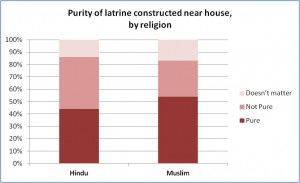Purity, latrine use, and religion
— Blog Post — 2 min read
From the SQUAT Survey, we found that many people prefer open defecation to latrine use, and that latrines are often seen as dirty and unpleasant. Through our conversations with people in rural India, it seems that part of this distaste is rooted in notions of purity and pollution: many expect latrines to emit foul smells, which are often seen as unhealthy and disease-inducing, and are averse to the periodic cleaning that pits require.
We asked our respondents what they thought about latrines and open defecation in terms of purity. We asked whether they thought defecating in the open near or far from the house was pure or impure, and whether they thought a latrine constructed near or far from the house was pure or impure. This post focuses on impurity, since it is the perception of impurity that seems to be holding people back from latrine use.
For respondents overall, defecating in the open near the house is considered the most impure out of all defecation practices listed (a full 91% say it’s impure), while latrine construction far from the house is considered to be the least impure (only 4% say it’s impure).
It is between latrine construction near the house and defecating in the open far from the house where there are differing opinions. The graph below shows the percentage of people who report each of these options as “impure” for respondents overall, just for toilet owners, and just for toilet users.
As we move from the overall sample, to those who own latrines, to those who actually use latrines, we see that more respondents report that open defecation far from the house is impure (from 42% to 51% to 59%), and fewer respondents report that latrine construction near the house is impure (42% to 39% to 37%). Of course we can’t know with our data which comes first – the ownership and use of the latrine, or changing beliefs around open defecation - but it is certainly interesting to see the connection between perceptions of purity and latrine practices in these trends.
So where might these ideas of purity come from? If ideas of purity are associated with latrines, we wanted to explore how religion may or may not influence these perceptions. What we find is that Muslims are less likely than Hindus to say that a latrine constructed near the house is impure. In the graph below, the bottom segment (dark red) shows the percentage of Hindu and Muslim respondents who reported that a latrine near the house is “pure” and the middle section (lighter red) shows the percentage of respondents who said that having a latrine near the house is “not pure.” In both segments we see that Muslims are less averse to having a latrine near the house.
In the context of knowing that Muslims are much more likely to both own and use a latrine, we see a clear possibility. Ideas of purity and the cleanliness of latrines are cultural notions that appear to be holding back progress in eliminating open defecation for a majority of rural Indians.
These graphs tell us that it is going to be important both to convince people of the detrimental impacts of open defecation, and that there is nothing bad or dirty about latrines. How cultural perceptions shape these beliefs is something we need to examine more deeply. If indeed cultural forces are influencing sanitation outcomes, we need to develop a better understanding of them so that they can be fully incorporated in the design of government sanitation policy.

